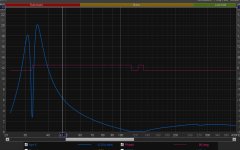40k was supposed to be Q4 2024, not sure if the LA was next year early or not.
You'll be looking at $500 each for the small LA and 40k, reportedly.
You'll be looking at $500 each for the small LA and 40k, reportedly.
These Dats setups are getting close to the cost of other OE test systems. I like my Clio pocket system. It can be hard to use in some situations requiring specific data parameters but its very capable though.
Manually testing static BL symmetry also isn't that hard to do with a dial indicator and a small adjustable DC power supply. You can check static VC heating as well.
I use the Dats V3 for quick and dirty measurements, but I can double check with my Clio. With a decent mic and using REW, all other acoustic measurments are covered. The amplifier built into the new DATS must be class D. Not sure that will be capable of the same HF performance of a decent class AB. Dayton doesn't have the best reputation for build quality based on my experiences. Their software can also be iffy.
Manually testing static BL symmetry also isn't that hard to do with a dial indicator and a small adjustable DC power supply. You can check static VC heating as well.
I use the Dats V3 for quick and dirty measurements, but I can double check with my Clio. With a decent mic and using REW, all other acoustic measurments are covered. The amplifier built into the new DATS must be class D. Not sure that will be capable of the same HF performance of a decent class AB. Dayton doesn't have the best reputation for build quality based on my experiences. Their software can also be iffy.
While at it, I was contemplating on this DC approach. In various Bl(x) and Kms(x) tests, various drivers show either zero position DC offset or high displacement DC offset. Some drivers are even manufactured that way to offset their nonlinearities, and with use, the driver rather centers itself towards the Xmax. What will be the consequences to this issue with DC measurements approach? Might it be that we measure in a static state that is not true in the dynamic state?
Seems like a natural evolution of the DATS V3. I've never had any problems with the DATS V3 hardware. I've even used it with REW from time to time (REW doesn't smooth the measurements like DATS does, so it's better at picking up box resonances, etc.). I was wondering when someone would just hardware a small but powerful class-D amp into the jig for large-signal measurement. Looks like the DATS V4's done it.
do we just hook up the dats and hit start? (instead of the dats software inthis case)
Last edited:
Apparently, the dome drivers are not under the Epique banner.
Also, the Omnimic 40k is now $600, regular price.
DATS-LA is now available with a 100W amp, the smaller model of the 2 mentioned.
Also, the Omnimic 40k is now $600, regular price.
DATS-LA is now available with a 100W amp, the smaller model of the 2 mentioned.
Last edited:
The ‘REW’ impedance measurement says Fb is ~ 33hz and the date v3 software says ~23hz?
I’m Guessing I need to set a resistor calibration value?
I'll have to find my notes for when I last used it. But the value of the calibration resistor should affect only the magnitude, not the frequency at Fb.
This would be great if we could measure the Large Signal Parameters with REW , would be highly grateful if can you please share the method you use REW to assess the below parameters -You can do large signal parameter measurement at whatever power levels you want right now for free with REW.
1. Suspension linearity to motor linearity and the suspension systems ability to inhibit the coil from moving out of the gap, will help understand driver performance - Under Large Signals. & its contribution to distortion.
2. Motor structure linearity over both cycles upto X Max. & its contribution to distortion.
Thanks a lot, Suranjan
Those 2 things are nonlinearities, you can not measure those with REW. Large signal parameters are measured the same way as small signal; just with a higher input voltage.
Audio Judgement on Youtube has a couple videos about measuring parameters with REW, and in one of the videos he shows you how to use an amplifier to measure large signal parameters at whatever voltage you want.
Audio Judgement on Youtube has a couple videos about measuring parameters with REW, and in one of the videos he shows you how to use an amplifier to measure large signal parameters at whatever voltage you want.
- Home
- Loudspeakers
- Subwoofers
- New ‘DATS’ from Dayton
